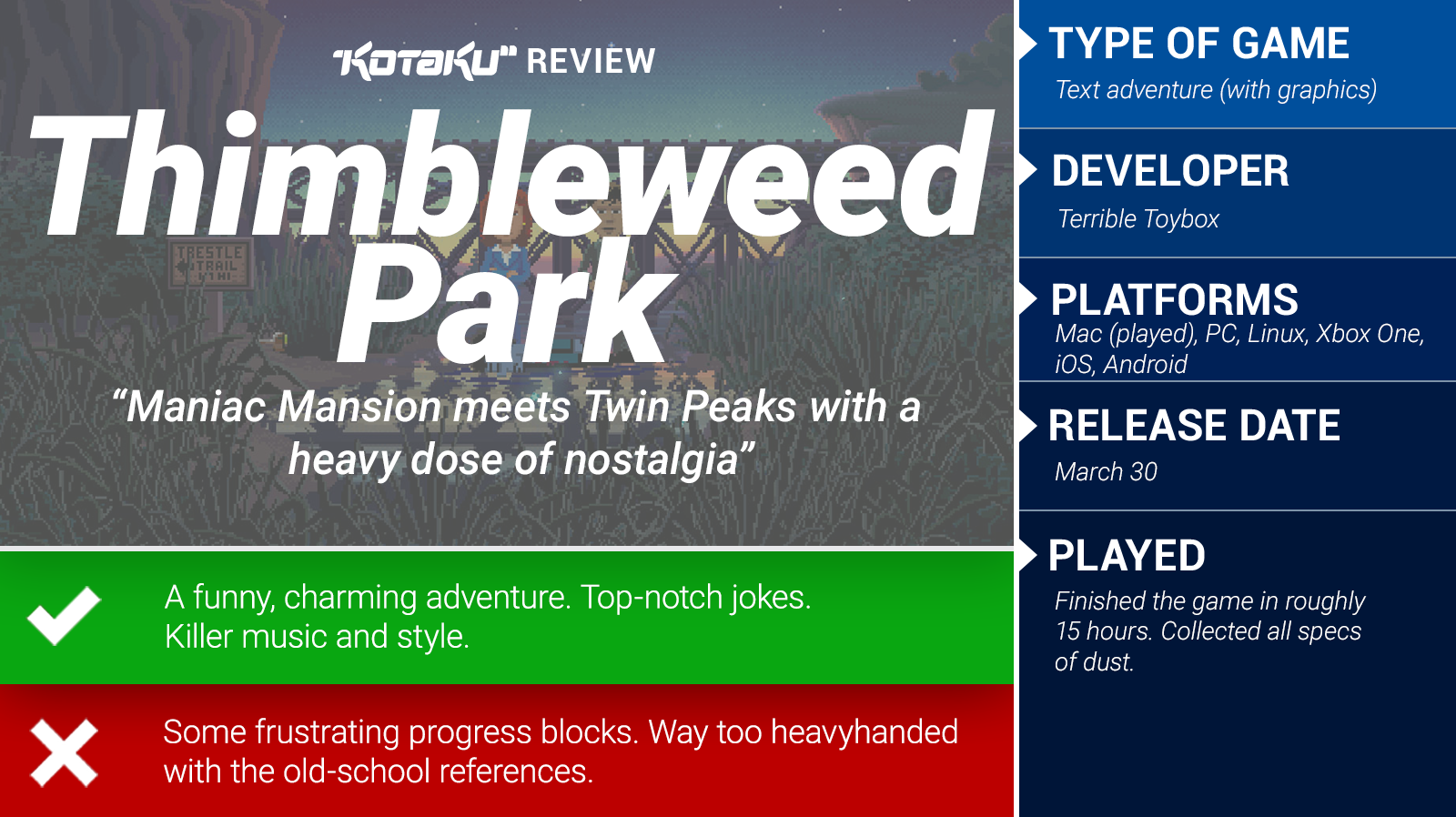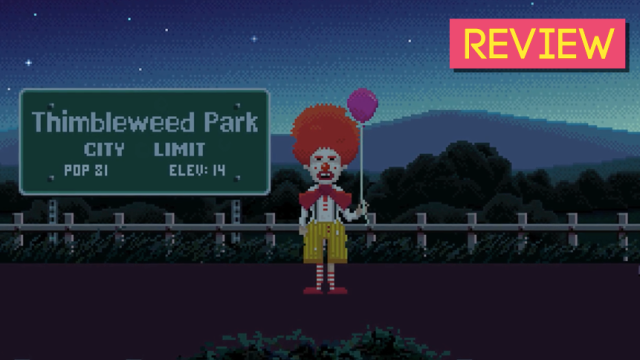Early in Thimbleweed Park, a new graphical adventure game, a pair of pigeon-suited plumbers tell you not to worry about dying, because there’s no way to lose in this game. “But playing classic adventure games has taught me to save often,” your hero replies.
“That was true up until Monkey Island,” say the plumbers. “Then the designers realised that death and dead-ends weren’t making the game more enjoyable.”
“That seems like a sensible approach to adventure game design,” says your hero.
It’s the first of many charming fourth-wall-breakers in Thimbleweed Park, a game that, more than anything, is about celebrating point-and-click adventures. Designed and programmed by many of the same people who developed LucasArts classics like Monkey Island and Maniac Mansion (including Ron Gilbert, David Fox, and Gary Winnick), Thimbleweed Park is full of meta-humour, in-jokes, and enough old-school references to choke a three-headed monkey.
When Gilbert and crew first pitched the game on Kickstarter back in 2014, they said they wanted to make something that felt like “an undiscovered classic LucasArts’ adventure game you’d never played before.” In that, they have succeeded. Like all of those old adventure games, Thimbleweed Park is stylish and hilarious. It’s too heavy-handed with the easter eggs, and some of the puzzles are frustrating for the wrong reasons, but isn’t that what you’d expect from a point-and-click adventure?

At the beginning of Thimbleweed Park, which is set entirely in the town of the same name, you meet two detectives named Ray and Reyes. Ray is a jaded veteran, Reyes is an easy-going amateur, and both are here to uncover who killed the man by the river outside of town.
As you play further, you’ll unlock three more playable characters: Franklin, a nebbish ghost; Ransome, a foul-mouthed clown; and Delores, a charming, nerdy video game programmer who’s also the secret star of Thimbleweed Park. (One of her first goals is to get a job at a LucasArts proxy making adventure games.)
By the time you’ve gotten past the first act, you’ll be able to switch between all five of these characters, Maniac Mansion-style, using them to swap items and solve puzzles throughout the world.
By “solve puzzles” I mostly mean “smash items together,” because this is a point-and-click adventure game. You’ll explore Thimbleweed Park, talk to its bizarre residents, and try to pick up every object that isn’t nailed down. Then you’ll use those objects to solve puzzles and unlock new parts of the environment.
Early on, for example, you’ll need to take a photo of the dead body. One detective has the camera; the other detective has film. So you’ll have to give the film to the agent holding the camera (or vice versa), then use the film on the camera to load it up, and then use the camera on the corpse to take a picture.
As the game goes on, these puzzle chains grow increasingly silly and complicated, as do your interactions with the inhabitants of Thimbleweed Park. (My favourite: an intrepid newspaper journalist who really wants to win a Pulitzer.) The puzzles can get difficult but rarely feel unfair, and when you solve them, you’re usually rewarded with something fun, be it a new area, some gorgeous art, or a good joke. (There are lots and lots of good jokes.)
What makes Thimbleweed Park great — and what made me enjoy all ~15 hours I spent with the game, even the ones where I did nothing but walk in circles — is this vibe. Thimbleweed Park blends the creepiness of Twin Peaks with the humour of Monkey Island in one stylish, successful package. It all looks spectacular, from the rotting food covering the old abandoned circus to the flickering lights illuminating the disheveled buildings of Thimbleweed.
The dialogue is a blast — do yourself a favour and talk to everyone as often as possible — and the music is stellar, alternating between guitar twangs and disco drops to great effect. You’ll also find old-school references on every corner, which is fun at first (oh look, it’s Chuck the Plant!) but can get a little grating by the 20th or 30th LucasArts callback. Still, this is one of the funniest games I’ve played in a long time.
The murder victim’s corpse never moves, by the way. It just sits there, slowly degrading — “pixelating,” the game says — as you play through the game, taunting you to figure out what happened. The answer to that question isn’t particularly interesting, and in fact, by the end of the game you’ll have to piece together most of the murder on your own. Because Thimbleweed Park is really about a deeper mystery, one that lies at the heart of the abandoned Pillow Factory in the center of town.
It’s hard to get too analytical without spoiling Thimbleweed Park‘s big secret, but I’ll say this: the game’s ending is dumb, hilarious, mind-blowing, and a little unsatisfying.
Ron Gilbert has talked before about how the best adventure games always give the player very specific goals. You don’t want to be wandering around trying to figure out what to do next; you want to be wandering around trying to figure out how to do what you want to do next. To accomplish this, Thimbleweed Park sticks every character with a personalised to-do list that lays out their objectives. Find the murder weapon! Escape the hotel! Get Ransome the Clown’s makeup and joke book so he can go on stage and insult an ancient gypsy woman, who casts a curse that ruins his life and prevents him from taking off his makeup!
For the most part, this system works well, and it usually feels like you’re making good progress as you explore the surreal mansions and creepy sewers of Thimbleweed Park. The game’s best puzzles require you to swap between multiple heroes at the same time, using one character to distract a citizen as your second character steals all of his stuff. (Or something like that. These puzzles are too good to spoil.)
There are, however, times where you might do something out of order and find yourself in a situation where you think you know what to do, but actually don’t. For example, you might accidentally stumble upon a bush in the forest before talking to the person who tells you where to find that bush, then spend 2-3 hours combing the entire game and trying every possible combination of items, only to find out that all you had to do was bring Delores to talk to that one person in town. (Don’t judge me.)
The game’s other weird quirks can be also be distracting, like what appear to be remnants of cut puzzles. Early in the game, one storekeeper mentioned having a Betamax player (Thimbleweed Park is set in 1987, which makes for some fun jokes), so I made a mental note that I’d probably have to go back there. Later, I got a Betamax tape, only for my character to insist that there were no Betamax players anywhere in Thimbleweed Park. When I went back to the storekeeper, he wouldn’t help. Turns out it was all just a red herring.
Ask any fan of point-and-click adventures for their least favourite part of the genre and they will no doubt give you the same answer: Pixel hunting. Old LucasArts and Sierra games, for all of their charm, liked to stick objects in obscure places, asking the player to sweep his or her mouse across every screen just to find the solutions to otherwise standard puzzles.
Ron Gilbert and his team have no doubt heard this complaint many, many times before. So in Thimbleweed Park, they offered a solution: More pixel hunting. Throughout the game there are something like 70 “specs of dust,” each illustrated as a single grey pixel. Compulsive gamers will no doubt want to collect them all, combing the world’s streets and buildings for little pixels just for the sake of completing the task on their to-do lists that says “collect [#] more specs of dust.”
It soon becomes clear that these specs of dust don’t do anything. They’re just there to be collected, to be hunted down like the pixels of old, and there’s something inexplicably addictive about watching them accumulate in your characters’ inventories.
This is simultaneously a joke about pixel hunting, a joke about adventure games, and a joke about the dumb things that players will do in video games. Did you ever think you’d want to hunt for pixels again? And did you ever think that the act of hunting pixels might be fun? Thimbleweed Park somehow both subverts pixel-hunting and makes you want to hunt pixels, which is just about all you can ask for in an adventure game.

Comments